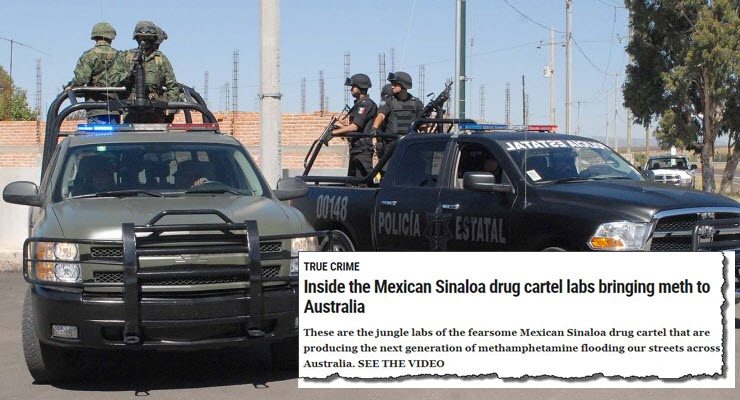OPENMENU
The Sydney Morning Herald
SUBSCRIBELog in
Advertisement
ExclusiveNationalNSWCrime
This was published 1 year ago
'Like any other international commerce': Mexican cartels make big business out of Australia's meth trade
You have 5 free articles remaining
Get a well-balanced perspective with the Herald.
FIND OUT MORE
Already subscribed? Log in
Lucy Cormack
By Lucy Cormack
January 19, 2020 — 12.05am
Save
Share
Normal text sizeLarger text sizeVery large text size
The outdoor laboratory was set in the depths of a remote area in north-western Mexico.
Concealed in tropical forest-like scrub, the area near Culiacan, Sinaloa, was surrounded by rural farms lined with creeks and other water sources. It took a bumpy 45-minute drive down a dirt road just to reach the lab.
Culiacan, Mexico, has long been home to an underground economy through which illicit drugs are exported to the United States.
Culiacan, Mexico, has long been home to an underground economy through which illicit drugs are exported to the United States. CREDIT:AP
When Australian Federal Police Detective Superintendent Conrad Jensen first visited the site in October, it was not the first he had seen like it.
"We are seeing very large-scale drug laboratories operating here in Mexico. A lot of equipment is involved in these operations, [which] might cost anywhere from $500,000 to $1,000,000 to set up."
Advertisement
And with that, he said, "you've got people producing meth".
As the AFP's senior officer in Mexico City, Detective Superintendent Jensen routinely liaises with his local counterparts about the growth of such labs, which have become a major part of operations for Mexico's most infamous drug cartels, including the Sinaloa Cartel and CJNG - the Jalisco New Generation Cartel.
Methylamphetamine is the most commonly consumed illicit substance in Australia, vastly exceeding cocaine, heroin and MDMA.
Methylamphetamine is the most commonly consumed illicit substance in Australia, vastly exceeding cocaine, heroin and MDMA.CREDIT:NSW POLICE
The Sinaloa cartel is believed to be the biggest supplier of cocaine and ice to Australia.
"Certainly the priority for us is the methylamphetamine coming out of Mexico supplying the Australian market," Detective Superintendent Jensen said.
Advertisement
A third of the methylamphetamine that is consumed in Australia is believed to originate in Mexico.
RELATED ARTICLE
What are the Mexican drug cartels?
Explainer
Crime
Who are the Mexican drug cartels and why are they so deadly?
"It was estimated that lab, near Culiacan, was producing about 20 tonnes of meth per month. Compare that to Australia's wastewater analysis that suggests Australians are using about 10 tonnes of meth per year," Detective Superintendent Jensen said.
"That's just one lab of many dozens we are seeing up that way."
Methylamphetamine, more commonly known as "ice", is the most commonly consumed illicit substance in Australia, vastly exceeding cocaine, heroin and MDMA.
Advertisement
In the year to August 2018, the National Wastewater Drug Monitoring Program found Australians consumed more than 9.8 tonnes of the drug, an increase of more than one tonne from the previous year.
Meanwhile, the Australian Criminal Intelligence Commission estimates the nation spent $9.3 billion on illicit drugs in 2018.
Australia's demand for ice and the growing supply from Mexico prompted the creation of the AFP Mexico City post, a role which Detective Superintendent Jensen has held since its opening in 2017.
"We've seen a change in the drug trade from Mexico in the past two or three years. Certainly, we have seen a huge increase in the amount of meth coming out to the Australian market."
He pointed to the largest ever meth seizure in the US in January last year, when 1.7 tonnes of ice was intercepted in shipping containers in Los Angeles, bound for Australia. The amount seized was equivalent to 17 million street drug deals valued at $1.29 billion.
Advertisement
"That gives you a scale of what we are dealing with ... cartels are diversifying their business, and part of that is moving into synthetic drugs like meth which they can produce in Mexico, [unlike] cocaine only being produced from coca leaves in South America," he said.
"Generally the bulk of precursor chemicals used for manufacturing will come from Asia as it's cheaper to source."
A shipment of more than 1.7 tonnes of methylamphetamine seized in the US last year.
A shipment of more than 1.7 tonnes of methylamphetamine seized in the US last year.CREDIT:AFP
He added that the Mexican method used to manufacture methylamphetamine generally produces meth considered to be "better quality" than that from Asia, a large factor in the "supply and demand" of the drug from the region.
Three states along the Pacific side of Mexico have seen greater targeting of drug labs in recent years: Sinaloa, Gurreiro and Michoacan, all of which are in close proximity to some of the country's largest shipping ports and commercial shipping routes.
Advertisement
While the bulk of methylamphetamine in Australia is trafficked by commercial shipping, there is no direct shipping between Mexico and Australia. So illicit substances will always reach local shores via Asia or the US, as was the intention for the 1.7 tonnes seized in California in January.
RELATED ARTICLE
The flourishing illegal drug network in South-East Asia
Organised crime
Criminal networks importing 'staggering' amounts of ice into Australia: UN
Around 7,000,000 shipping containers pass through Australia's docks every year.
Detective Superintendent Jensen said there was no doubt Mexican cartels had Australia in their sights, where high prices for drugs made the long and difficult journey worthwhile.
"Their model in markets like Australia is to work cooperatively with [local] drug groups who are the experts in distribution," he said.
That means outlaw motorcycle gangs, and other criminal groups who are "experts at distributing whatever drug type in the big cities of Australia".
"You have powerful cartels in this part of the world and they need to develop those markets by talking to criminal groups," he said.
"It's like any other sort of international commerce going on."

